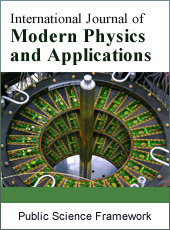International Journal of Modern Physics and Applications
Articles Information
International Journal of Modern Physics and Applications, Vol.2, No.3, May 2016, Pub. Date: Sep. 3, 2016
A Magnetic Field Transducer Based on the Mechanoelectric Effect in Semiconductors
Pages: 15-17 Views: 4426 Downloads: 1109
[01]
Sh. M. Aliev, Institute of Physics, Daghestan Science Center, Russian Academy of Sciences, Makhachkala, Daghestan, Russia.
[02]
I. K. Kamilov, Institute of Physics, Daghestan Science Center, Russian Academy of Sciences, Makhachkala, Daghestan, Russia.
[03]
K. M. Aliev, Institute of Physics, Daghestan Science Center, Russian Academy of Sciences, Makhachkala, Daghestan, Russia.
[04]
N. S. Abakarova, Institute of Physics, Daghestan Science Center, Russian Academy of Sciences, Makhachkala, Daghestan, Russia.
[05]
M. Sh. Aliev, Institute of Physics, Daghestan Science Center, Russian Academy of Sciences, Makhachkala, Daghestan, Russia.
[06]
Zh. G. Ibaev, Institute of Physics, Daghestan Science Center, Russian Academy of Sciences, Makhachkala, Daghestan, Russia.
A sensitive magnetic field transducer based on the mechanoelectric effect in semiconductors is designed. The transducer is a magnetic dipole with the central axis of rotation, on poles of which are mounted side needles which can exert mechanical pressure on a fixed strain-sensing semiconductive elements. The I-V curves of the semiconductive elements lead to modification in the magnetic field. The I-V curves show that the reverse I-V branch is more sensitive to the magnetic field than the forward one. The sensitivity of the produced transducer is 3.0×103 V/A Oe.
Magnetic Field, Magnetic Dipole, Semiconductor, p-n Junction, Current-Voltage Characteristic, Mechanoelectric Effect
[01]
A. L. Polyakova, Deformation of Semiconductors and Semiconductor Devices, Izdatel’stvo “Energia”, Moskow, 1979, P. 167.
[02]
I. I. Krivonosov, Semiconductor Electroacoustic Converters in Radio Circuit, Izdatel’stvo “Energia”, Moskow, 1977, P. 87.
[03]
Y. Matukura, Japan. J. Appl. Phys. 4 (1965) 632.
[04]
J. J. Wortman, J. R. Hansen, R. M. Burger, J. Appl. Phys. 35 (1964) 2122.
[05]
J. Oda, Japan. J. Appl. Phys. 5 (1966) 113.
[06]
H. Okamoto, H. Arigoshi, Y. Mizushima, Solid State Electronics 12 (1969) 441.
[07]
N. Moza, S. Bermon, F. H. Pollak, Phys. Rev. Lett. 28 (1972) 225.
[08]
W. Bernard, W. Rindner, H. Roth, J. Appl. Phys. 35 (1964) 1860.
[09]
I. N. Kupenko, A. L. Polyakova, Physics and Technology of Semiconductors 10 (1976) 807.
[10]
M. K. Bakhadyrkhanov, Kh. M. Iliev, Kh. F. Zikrillaev, Technical Physics Letters 22 (1998) 23.
[11]
G. G. Babichev, S. I. Kozlovski, V. A. Romanov, N. N. Sharan, Technical Physics 10 (2000) 45.
[12]
S. Chikazumi, Physics of Ferromagnetism, Izdatel’stvo “Mir”, Moscow, 1987, P. 302.

ISSN Print: 2381-6945
ISSN Online: 2381-6953
Current Issue:
Vol. 7, Issue 1, March Submit a Manuscript Join Editorial Board Join Reviewer Team
ISSN Online: 2381-6953
Current Issue:
Vol. 7, Issue 1, March Submit a Manuscript Join Editorial Board Join Reviewer Team
| About This Journal |
| All Issues |
| Open Access |
| Indexing |
| Payment Information |
| Author Guidelines |
| Review Process |
| Publication Ethics |
| Editorial Board |
| Peer Reviewers |


